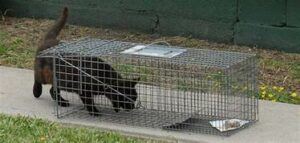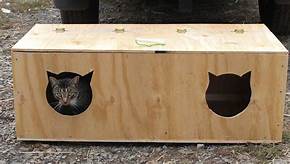 Greetings from Lucinda the literate cat. My CCL (Cantankerous Cat Lady) has asked me to write something a bit different. Since I am a cat, she feels I can give the best answer to the question, “can feral cats be domesticated?”
Greetings from Lucinda the literate cat. My CCL (Cantankerous Cat Lady) has asked me to write something a bit different. Since I am a cat, she feels I can give the best answer to the question, “can feral cats be domesticated?”
She wants me to describe the process as if I were the one being tamed, as I can express the feelings of the cat better than she. I hope you enjoy my attempt at this subject.
First of all, perhaps you should know that two-legged cat rescue experts classify us cats into three categories: Socialized, or fully domesticated; semi-feral (sometimes called strays); and feral, basically wild animals.
For this story, we will assume that I am a feral cat, who grew up without any human contact. As a feral, I would have never learned how to interact with humans. Now, let us pretend that I am approached by one of these creatures.
They are so big! My feral instincts tell me that they are predators, hunting us down for a tasty lunch. No way will I let that big creature get close to me.
Now what is the big creature doing? It’s put down some sort of container, and I smell food. I won’t go close to investigate until that huge creature is gone. Then I’ll check.
investigate until that huge creature is gone. Then I’ll check.
Well, I am very pleased. I checked that food — my, it smelled heavenly, and I was starved! I smelled it carefully and sensed that it was good, so I gobbled it up. Then I went and hid in case that creature came back, and I took a long nap.
Next day
Well, it happened again. I watched from the cover of the woods as the two-legged monster put down more food. Why is the creature feeding me? Fattening me up so there will be more of me to munch on?
No matter — the creature can’t catch me if I run away and climb a tall tree.
I have observed that this creature knows some things about cats. It does not look me directly in the eye. Instead, it keeps its gaze on something else. This is reassuring. When an unknown large creature looks directly at you, it feels very threatening. I must learn to trust this newcomer before eye contact will be comfortable.
Next week
This procedure has gone on for several days. Recently, the tall being has started sitting down nearby where it can watch me eat. I keep a wary eye on the two-legged, but it just sits there. At least when it is sitting, it is a bit smaller and not quite so scary.
I’m noticing the creature sits closer and closer to the food as the days pass. However, it seems like it means no harm. I can sense a quiet patience, not a desire to leap and devour.
I can sense a quiet patience, not a desire to leap and devour.
I realize that the creature is now sitting right next to the food, and if I want it, I have to get very close. I think it’s okay — I still sense that quiet watchfulness.
Now it has started talking to me in a soft voice. I am close enough that I can smell that this one is a “she.” That’s reassuring, for some reason. Perhaps she has the need to mother something.
I don’t know — Today, she moved her hand slowly toward me. Again, she seems to mean no harm, so I will tolerate the closeness of the hand.
The next day
Well, she touched me! She kept talking to me in that low, sweet tone, and she stroked the top of my head. Now that I am so much closer, I can smell her better. I can smell waves of good feelings mixed with a little anxiety coming from her.
I really believe this “she” does not mean me harm. Perhaps she wants to be a mother, and having no children of her own, wants to add me to her family. Well, the food is good — I’ll vouch for that.
Now I’m in for it! She has started petting me, all over, and scratching my furry cheeks. I am in heaven! I had no idea a big creature like her could make a little creature like me feel so good. I consider myself fortunate to have met her.
Would you believe that today I let her pick me up? I must be crazy — why, she could carry me off to her lair and make short work of me. However, she just set me on her legs and gave me heavenly scratches and strokes.
Moving day
Well, I didn’t know I’d be moving, but I sure have found a new home! Today She came with a box that had handles, and, of course, a good meal. After I ate, She picked me up, talking sweetly, and put me in that box and fastened it shut.
I have since learned that often a feral cat is trapped with what is called a “live trap.” It has food inside, and once the  cat is in there eating, a door closes and the cat is captured. Often, cats are caught in these traps, taken in to the vet for the surgery that takes away their ability to have babies, and then released.
cat is in there eating, a door closes and the cat is captured. Often, cats are caught in these traps, taken in to the vet for the surgery that takes away their ability to have babies, and then released.
I didn’t have to be caught in a live trap, because She had spent time getting me used to her. Then She carried me to the place where she lives. It is amazing! It is a giant cave — the biggest I have ever seen. I guess it has to be pretty big, because She is so big.
Inside, the cave is divided into smaller caves. She took me in one and let me out of the box-thing. Here I discovered some food and water, a box of sand, should I feel nature’s urge, and a warm bed.
In a corner is a dark enclosure with a small door. I check this place out. It feels good. It feels like a secure place to

hide if I get scared. As time goes by, I learn that, if I am in that small cave, no one will bother me. It’s my safe spot.
I have explored the large cave thoroughly, believe me. I wanted to find out if there was any way to escape, should the need arise. Unfortunately, there are no windows open; no vents I can crawl in; nothing I can tear open to free myself. I am truly trapped.
Over those first days in the She-cave, She feeds me a little bit several times a day. Then She can come in and fuss over me and get me used to her presence and her way of behaving.
It’s funny — She knocks on the door with her hand before She comes in to feed me. I soon learn that when She knocks, food is coming — or at least She is coming. The knock is a good idea because it alerts me that She is coming in and I don’t run and hide in fright.
In a few days, She came in and put me in the box with the handles again. Is She going to take me back where She got me? Where are we going? I’m very afraid, because I cannot escape.
We go to a place that smells strange. There are other animals here, and I can tell they are frightened, and some of them are in pain. We go into a small room, and my carrier is put on a table and opened. Then strange hands grasp me and explore my body. In a short while, I feel something like a bee sting, and I suddenly go to sleep.

When I wake up, I am groggy. I am in the carry-box and She is here. We go to her cave, and She puts me in my special room. For a couple of days, I don’t feel too well. I am sleepy and my nether area hurts a bit. However, the food keeps coming, and She is very nice to me. Perhaps all will be well.
When She feeds me, she always makes the same sound, so I know food is coming. Also, She strings together some other sounds that are apparently a name She has given me, and I come to recognize She is talking to me when She uses it.
I am learning what a few of her sounds mean. This is helpful, as it becomes more like we are communicating.
Now that I am home, our regular feeding schedule continues. After I become very used to her and to the feeding routine, I begin to come out to meet her when She comes in. Now I have learned to trust her. Soon She lets me explore the rest of her giant cave.
Now I am a member of the family.
I hope you enjoyed my attempt at being a feral cat. My CCL had her own experience, taming two feral kittens many years ago. To read her story about that experience, go to https://theliteratecat.com/have-you-ever-tried-domesticating-a-feral-cat
The CCL found several online posts on this subject. We will list these references here in case you would like to read further on this subject.
One of these references gave three rules to sum up how to tame a feral cat, and I think they are good ones:
1) Try very hard not to scare the cat
2) Treat it nicely; talk to it sweetly
3) Don’t be in a hurry
Here are the references:
thecatniptimes.com/learn/how-to-tame-a-semi-feral-cat/
theluckyfew.org/site/feral_cats.html
pethelpful.com/cats/how-to-tame-a-wild-cat
Thank you for reading this post. If you have had your own experience with training a feral cat, please tell us about it in the comments below.


Lucinda,
You certainly know your stuff when it comes to helping us humans understand things from a cat’s point of view. I know this one guy that has adopted about a dozen feral cats that live at the beach. He is the only one that can go near them and they even let him give ’em a scratch when he brings the food around. I don’t know if he’s heard about the TNR (trap-neuter-return) program we have here, but this would be a good occasion to put it to use. https://www.jaxhumane.org/services-and-resources/communitycats/
I’m not fond of the idea of tipping but at least it’s done during the spay/neutering process and causes no discomfort to the patient. I haven’t heard or read about a viable alternative to that practice and something certainly needs to be done as there are over 58 million strays/feral cats in the US alone and that number continues to grow. I would be interested in getting a cat’s point of view on that subject too if you can find the time. http://www.wildlife-removal.com/howmanystraycats.html
I’m looking forward to your next post!
Thank you so much for your informative post. You have given us much to think about. It sounds like Jacksonville has a great program in place for feral or semi-feral cats. I am aware that other communities have TNR programs, though it sounds like yours in Jacksonville should be a model for other parts of the country. Yes, I do believe it would be interesting to write a new post on this subject, and am sure that my CCL would agree. Time to do some more research.